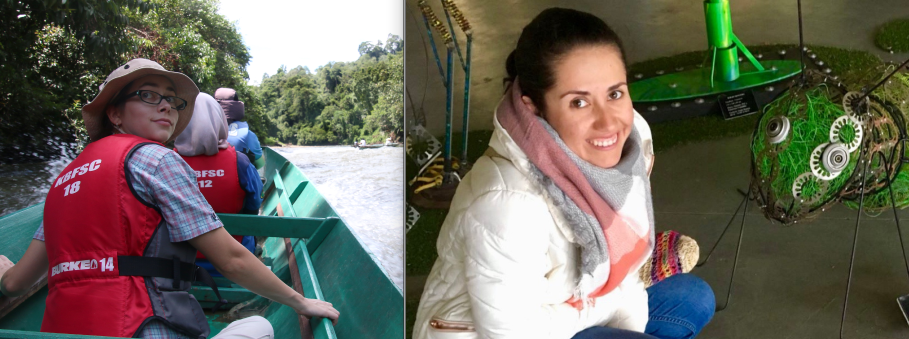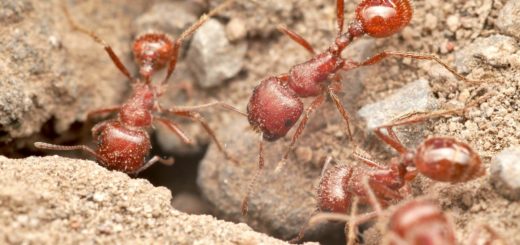Exploring intraspecific aggression in an invasive population of Cardiocondyla obscurior
In the recent paper “The role of cuticular hydrocarbons in intraspecific aggression in the invasive ant Cardiocondyla obscurior” published in Myrmecological News, Maja Drakula, Jan Buellesbach, and Lukas Schrader investigate cuticular hydrocarbons (CHC) in C. obscurior. CHCs serve as important cues for nestmate discrimination and intraspecific aggression in ants. In invasive ant species like Cardiocondyla obscurior, reduced CHC profile diversity is suspected to contribute to their ecological success by decreasing aggression between colonies. The authors use behavioral experiments and GC-MS analysis to demonstrate that CHCs are vital cues for modulating aggressive encounters between conspecifics. Here, first author Maja Drakula answers a few questions and highlights the main points of the study.
An Interview compiled by Maja Drakula, Jan Buellesbach, and Lukas Schrader



Edited by Alice Laciny and Lina Pedraza

MNB: Could you tell us a bit about yourself?
MD: I am a Master’s Student at the University of Münster, interested in evolutionary ecology. For this project, I worked on colony recognition cues and self/non-self discrimination in an invasive species of ants.
MNB: Could you briefly outline the research you published in Myrmecological News in layman’s terms?
MD: Chemical communication is the Earth’s most ancient and widespread form of communication. Particularly insects have exploited this mode of communication, and have evolved very sophisticated perception capabilities and complex chemical profiles to fine-tune their interaction with each other and the environment. For invasive ants, having colonized large habitats from their much smaller original distribution, it has been shown that uniformity in their chemical profiles is tightly linked to reduced aggressive behavior among them, potentially greatly contributing to their unparalleled ecological success. Despite being invasive, colonies of the heart-node ant Cardiocondyla obscurior still show aggression against each other. In our study, we correlated their chemical profiles with aggressive behavior from workers against queens of other populations.

MNB: What is the take-home message of your work?
MD: We discovered that more diverged chemical profiles lead to more aggressive interactions. This clearly showed chemical-based recognition mechanisms allowing workers to discriminate against queens from other populations in this invasive ant.
MNB: What was your motivation for this study?
MD: Intraspecific aggressive behavior is often low or absent in invasive ants, allowing the emergence of large networks spanning hundreds of nests that function as a single supercolony. However, in our study species Cardiocondyla obscurior, this does not seem to be the case as there is still aggressive behavior within the colonies between neighboring populations, particularly against queens. I have always been fascinated by how these aggressive interactions are triggered.

MNB: What was the biggest obstacle you had to overcome in this project?
MD: To test the impact of chemical profiles on aggressive responses, we had to perform a treatment where chemical profiles are removed or greatly reduced. Finding a method for that was the most challenging task. Also, as these ants are very tiny (1.5-3 mm), it was hard to analyze and identify all involved chemicals.
MNB: Do you have any tips for others who are interested in doing related research?
MD: Being patient and being inventive is probably the most important thing when doing behavioral experiments with animals. Especially observing the behavior of Cardiocondyla obscurior is difficult due to their small body size. So I recommend specifying a clear guideline beforehand on how to interpret the behavioral interactions as well as very thoroughly planning how to analyze and correlate the chemical profile divergence.
MNB: Where do you see the future for this particular field of ant research?
MD: Ants have evolved sophisticated means of chemical communication to regulate social interactions precisely. Our understanding of the intricate details remains superficial because of the considerable variation that evolved in chemical communication systems in general. Here, we have taken a step towards better understanding chemical communication in a prominent invasive antbut there is a lot more intense work needed to decipher the chemical signals underlying antagonistic interactions and the consequences for the species’ invasive potential.





Recent Comments